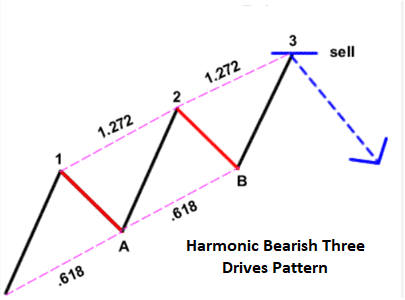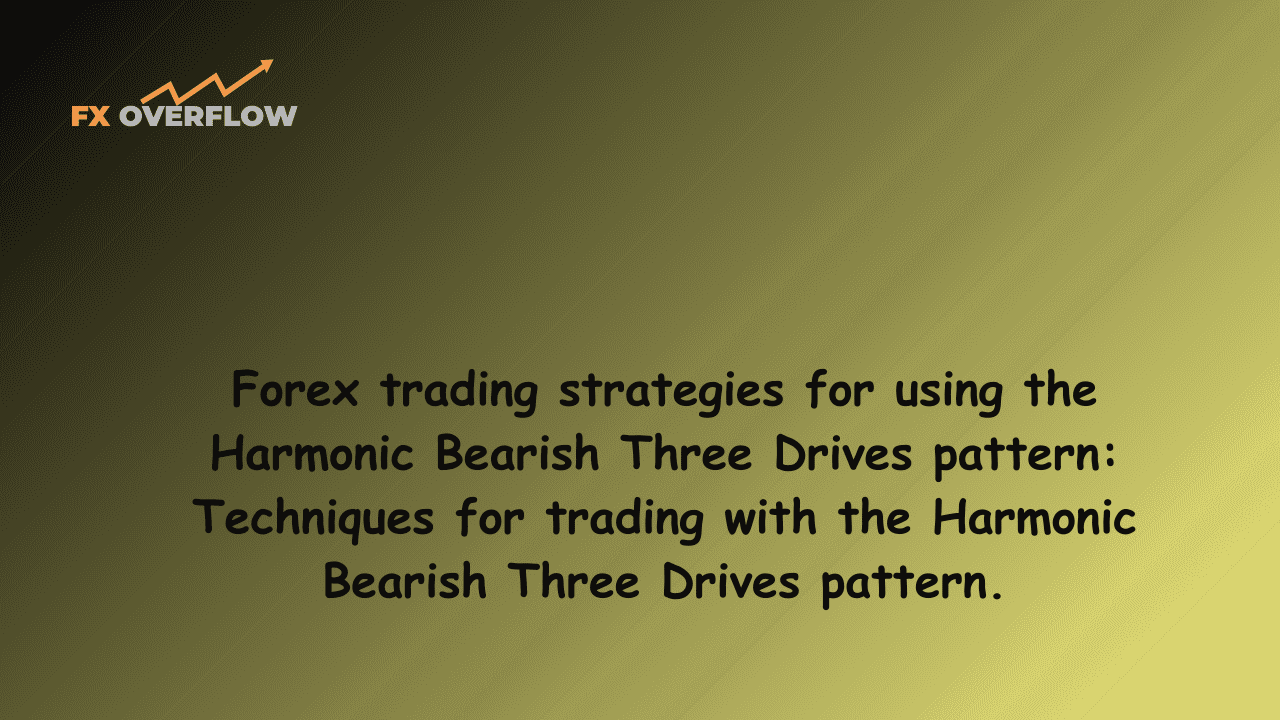Forex trading strategies for using the Harmonic Bearish Three Drives pattern: Techniques for trading with the Harmonic Bearish Three Drives pattern.
The world of forex trading is characterized by its complexity, volatility, and the myriad of strategies that traders employ to gain an edge in the market. One such powerful tool in a trader's arsenal is the Harmonic Bearish Three Drives pattern. This pattern, rooted in technical analysis, provides traders with valuable insights into potential price reversals and can be an effective component of a comprehensive trading strategy. In this article, we will delve into the depths of the Harmonic Bearish Three Drives pattern, exploring its intricacies and uncovering techniques for successful trading.
Table Content
I. Understanding the Harmonic Bearish Three Drives Pattern
II. Trading Techniques for the Harmonic Bearish Three Drives Pattern
1. Pattern Recognition
2. Confirming Confluence
3. Entry and Stop Placement
4. Fibonacci Extensions for Targets
5. Risk Management
6. Timeframes and Trends
7. Practice and Back testing
8. Patience and Discipline
III. Real-World Example: Applying the Harmonic Bearish Three Drives Pattern
IV. Footnote
Understanding the Harmonic Bearish Three Drives Pattern
Before we delve into trading strategies, it's essential to grasp the fundamentals of the Harmonic Bearish Three Drives pattern. This pattern is a type of harmonic price pattern, part of the larger family of Fibonacci-based patterns. It consists of three consecutive legs or drives that adhere to specific Fibonacci ratios. The pattern signals a potential reversal in an existing uptrend and is characterized by its bearish nature, implying an impending downward price movement.

The three drives within the pattern adhere to Fibonacci ratios of 0.618 and 1.272, forming the basis for the price extensions. The structure of the pattern resembles a mirror image of the Bullish Gartley pattern and is often identified by the AB=CD pattern. The drives often unfold in an A-B-C-D-E configuration, with point E acting as the reversal point.
Trading Techniques for the Harmonic Bearish Three Drives Pattern
1. Pattern Recognition: The first step in effectively using the Harmonic Bearish Three Drives pattern is accurate recognition. This requires a keen eye for detail and a thorough understanding of the Fibonacci ratios that govern the pattern's structure. Utilizing specialized charting tools and software can aid in identifying potential patterns.
2. Confirming Confluence: While the pattern itself holds significance, confirming its validity through confluence with other technical indicators adds a layer of reliability to your trading decision. Look for confluence with support and resistance levels, trendlines, or other chart patterns that suggest a potential price reversal.
3. Entry and Stop Placement: Determining the optimal entry and stop-loss points is crucial. Traders often place their entry orders near the completion of the pattern at point E. A common approach is to enter the trade once the price confirms a reversal by breaking below the point E level. Stop-loss orders can be placed slightly above point E to mitigate risk.
4. Fibonacci Extensions for Targets: Fibonacci extensions play a pivotal role in setting profit targets for trades based on the Harmonic Bearish Three Drives pattern. Traders often look to take profits at or near the 1.272, 1.618, or even 2.618 Fibonacci extension levels. This approach capitalizes on the expected price movement after the pattern's completion.
5. Risk Management: As with any trading strategy, risk management is paramount. Calculating position sizes based on risk tolerance and potential losses is vital for long-term success. The volatile nature of forex markets demands a disciplined approach to risk management to safeguard capital.
6. Timeframes and Trends: Combining the Harmonic Bearish Three Drives pattern with analysis of larger timeframes and overall market trends can enhance the accuracy of trading decisions. If the pattern aligns with the prevailing trend on higher timeframes, the likelihood of a successful trade increases.
7. Practice and Back testing: Before deploying the strategy in live markets, it's advisable to practice and refine your approach through back testing. This involves analyzing historical price data to assess the effectiveness of your trading strategy. Back testing helps identify strengths and weaknesses, enabling you to fine-tune your approach.
8. Patience and Discipline: Successful trading demands patience and discipline. The Harmonic Bearish Three Drives pattern may not occur frequently, and not all instances will result in profitable trades. Waiting for high-quality setups that align with your strategy is essential for consistent results.
Real-World Example: Applying the Harmonic Bearish Three Drives Pattern
Imagine a scenario where the EUR/USD currency pair has been on an uptrend for some time. You identify a potential Harmonic Bearish Three Drives pattern forming on the daily chart. The first drive (A to B) extends from 1.1000 to 1.1500, and the second drive (B to C) retraces to 1.1300. The final drive (C to D) reaches 1.1480.
You closely monitor the pattern's completion, and once the price breaks below point E at 1.1450, you enter a short trade with a stop-loss order at 1.1505. As the price moves downward, you use Fibonacci extensions to set profit targets. The 1.272 Fibonacci extension aligns with 1.1350, the 1.618 extension with 1.1250, and the 2.618 extension with 1.1050.
The trade unfolds, and the price reaches your first profit target at 1.1350. At this point, you decide to move your stop-loss order to breakeven to protect your gains. The price continues its descent, eventually hitting the 1.618 extension at 1.1250, where you choose to close the trade.
In this hypothetical example, the Harmonic Bearish Three Drives pattern helped you capture a significant portion of the downward price movement, resulting in a profitable trade. It's important to note that real-world trading involves inherent risks, and not all trades will yield positive outcomes.
Footnote
The Harmonic Bearish Three Drives pattern is a versatile tool that empowers traders with insights into potential price reversals. By combining the power of Fibonacci ratios with technical analysis, traders can develop effective strategies to navigate the complexities of the forex market. However, like any trading strategy, success is rooted in continuous learning, practice, and disciplined execution. Incorporating the Harmonic Bearish Three Drives pattern into your trading arsenal can significantly enhance your ability to make informed and profitable trading decisions.











Discussion